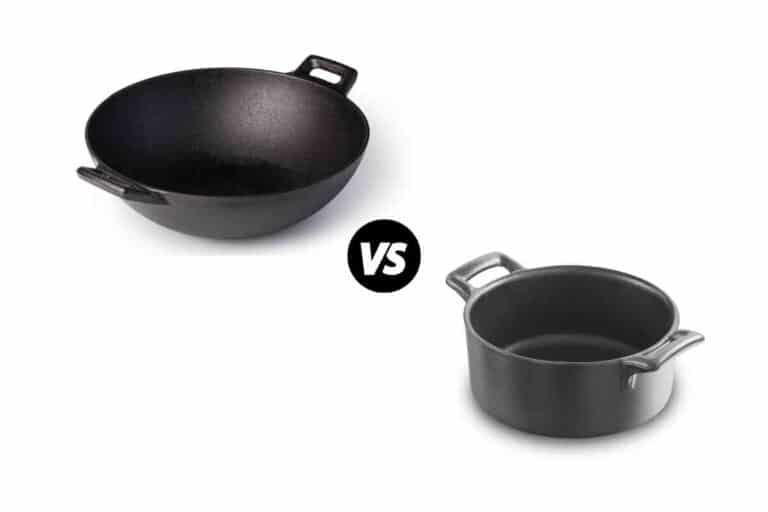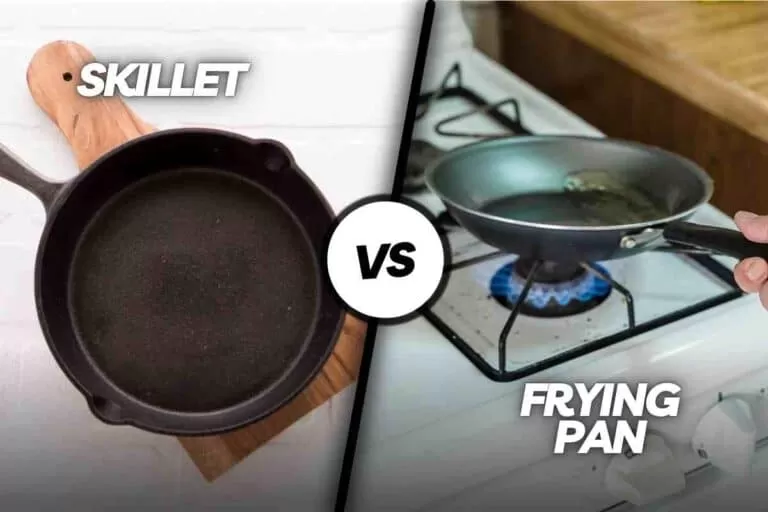7 Key Differences: Dutch Oven Vs Slow Cooker
The main difference between a Dutch Oven and a Slow Cooker is their design and method of operation. A Dutch oven is a versatile, heavy cooking pot that can be used on the stovetop or inside the oven. In contrast, a Slow Cooker, often referred to as a crock pot, is an electric appliance designed for countertop use.
While both can be used for slow cooking, a Dutch oven offers more flexibility for tasks like braising, baking bread, or making pasta due to its ability to function both on the stove and in the oven.
Consequently, Dutch ovens are generally considered more versatile and can produce dishes with richer flavors.
7 Aspects: Dutch Oven Vs Slow Cooker
| Aspect | Dutch Oven | Slow Cooker |
|---|---|---|
| Searing and Braising | ✔️ Ideal for searing and braising | ❌ Doesn’t sear, focused on slow cooking |
| Convenience | ❌ Requires stovetop for searing | ✔️ Set-and-forget convenience |
| Cooking Times | Varied cooking times, often faster | Longer, low, and slow cooking |
| Consistency and Reduction | ✔️ Allows for a reduction on the stovetop | ❌ May produce thinner braises |
| Capacity and Size | Various sizes available | Mostly large capacities (7+ quarts) |
| Energy Efficiency | ❌ Higher energy use for searing | ✔️ Generally more energy-efficient |
| Cleanup | May require more effort | Relatively easy to clean |

Understanding the Key Differences
Before we dive into the details, let’s get a clear picture of what sets these two kitchen essentials apart.
Dutch Oven Advantages
Searing and Braising in One Pot
One of the standout features of a Dutch oven is its ability to sear and braise in a single vessel.
Thanks to its stovetop compatibility, you can start by searing meat or sautéing onions and garlic, then seamlessly transition to slow cooking without dirtying extra pans.
This makes Dutch ovens perfect for dishes like coq au vin, where the initial browning of chicken is essential for flavor development.
Slow Cooker Advantages
Convenience and Set-and-Forget Cooking
Slow cookers, on the other hand, are the champions of convenience. They’re designed for those busy days when you want to prep your ingredients in the morning, set the cooker, and return to a home filled with the aroma of a well-cooked meal.
Slow cookers also shine at keeping dishes warm during gatherings or potlucks, making them a go-to for social cooks.
Cooking Times and Guidelines
Now that we understand the primary advantages let’s delve into the nitty-gritty of cooking times and guidelines for both Dutch ovens and slow cookers.
Comparing Cooking Times
Here’s a rough guide to cooking times for various ingredients in both Dutch ovens and slow cookers:
Chicken:
- Dutch oven: 1 to 1 1/2 hours
- Slow cooker (high setting): 2 hours
Cubed Meat (lamb, beef, or pork):
- Dutch oven: 2 to 3 hours
- Slow cooker (high setting): 2 to 3 hours
Whole Shanks or Larger Cuts:
- Dutch oven: 3 to 4 hours
- Slow cooker (high setting): 4+ hours
Beans (after soaking overnight):
- Dutch oven: 1 to 2 hours
- Slow cooker (high setting): 2 to 3 hours
Remember, these are approximate guidelines. Cooking times can vary depending on your specific recipe, the size of your ingredients, and the temperature settings. It’s always a good idea to monitor the doneness of your dish closely.
Consistency and Reduction
One thing to note is that slow cookers may produce thinner braises and stews compared to Dutch ovens. This is because slow cookers don’t allow for as much reduction due to their sealed cooking environment.
If you prefer a thicker consistency, you can easily remedy this by transferring your dish to the stovetop and reducing it further to your desired thickness.
Capacity and Size
Size Matters: Dutch Ovens vs Slow Cookers
Dutch ovens come in various sizes, typically ranging from 3 quarts to 7 quarts or more. This variety allows you to choose the size that best suits your cooking needs.
Whether you’re making a small batch of soup or a hearty stew for a crowd, there’s a Dutch oven size that’s just right.
On the other hand, most slow cookers have large capacities, usually around 7 quarts or more. This makes them ideal for cooking large portions of chili, pulled pork, or other dishes for gatherings and events.
If you have a big family or love hosting dinners, a slow cooker’s generous capacity may be a significant advantage.
Conclusion
In the eternal debate of Dutch oven vs. slow cooker, there’s no one-size-fits-all answer. Your choice should depend on your cooking style, the recipes you love, and your lifestyle.
If you appreciate the art of searing and the convenience of a versatile pot, a Dutch oven might be your culinary companion. It’s perfect for creating dishes that require that initial burst of flavor from browning meat or vegetables.
FAQs:
Can I Use a Slow Cooker Recipe in a Dutch Oven and Vice Versa?
Yes, you can often adapt recipes between the two. Just keep in mind the differences in cooking times and the need for stovetop searing when using a Dutch oven.
Are Dutch Ovens and Slow Cookers Easy to Clean?
Both are relatively easy to clean, but Dutch ovens may require more effort if food gets stuck to the bottom. Slow cooker liners can make cleanup even simpler.
Which One Is More Energy-efficient?
Slow cookers are generally more energy-efficient because they use lower cooking temperatures over a longer time, while Dutch ovens require stovetop and oven heating.






